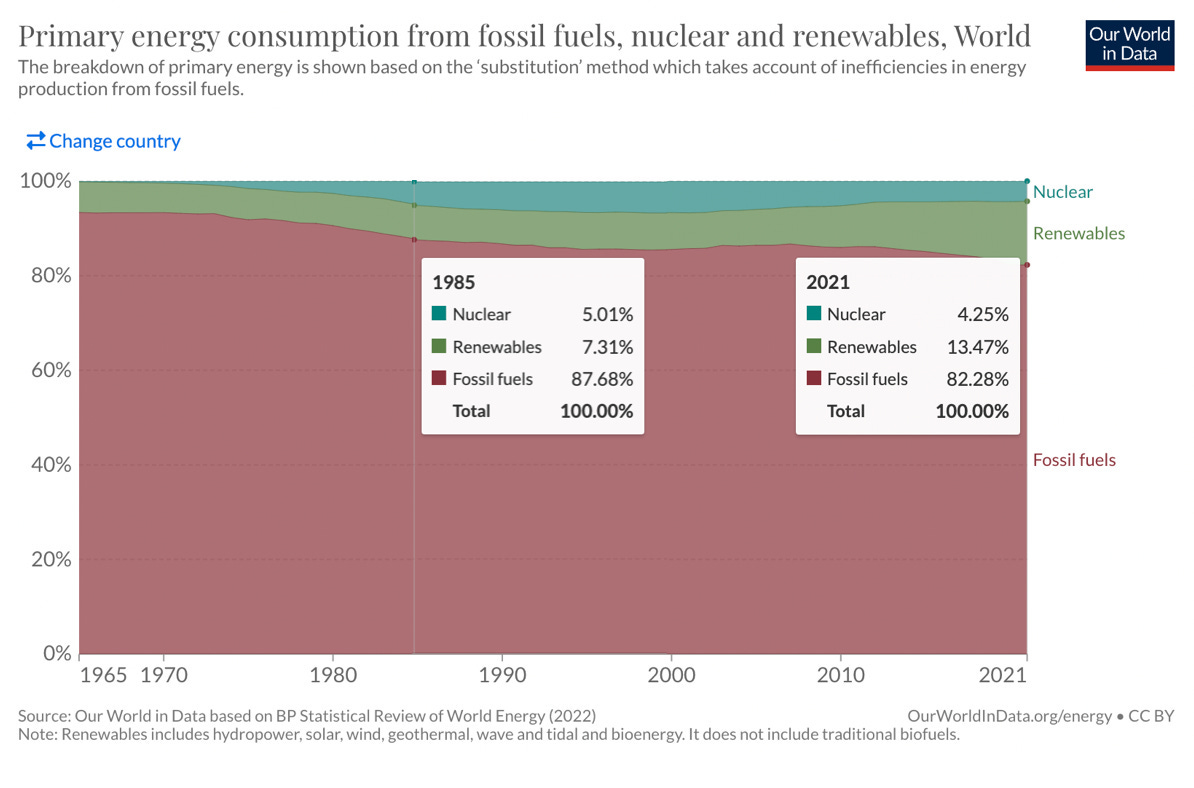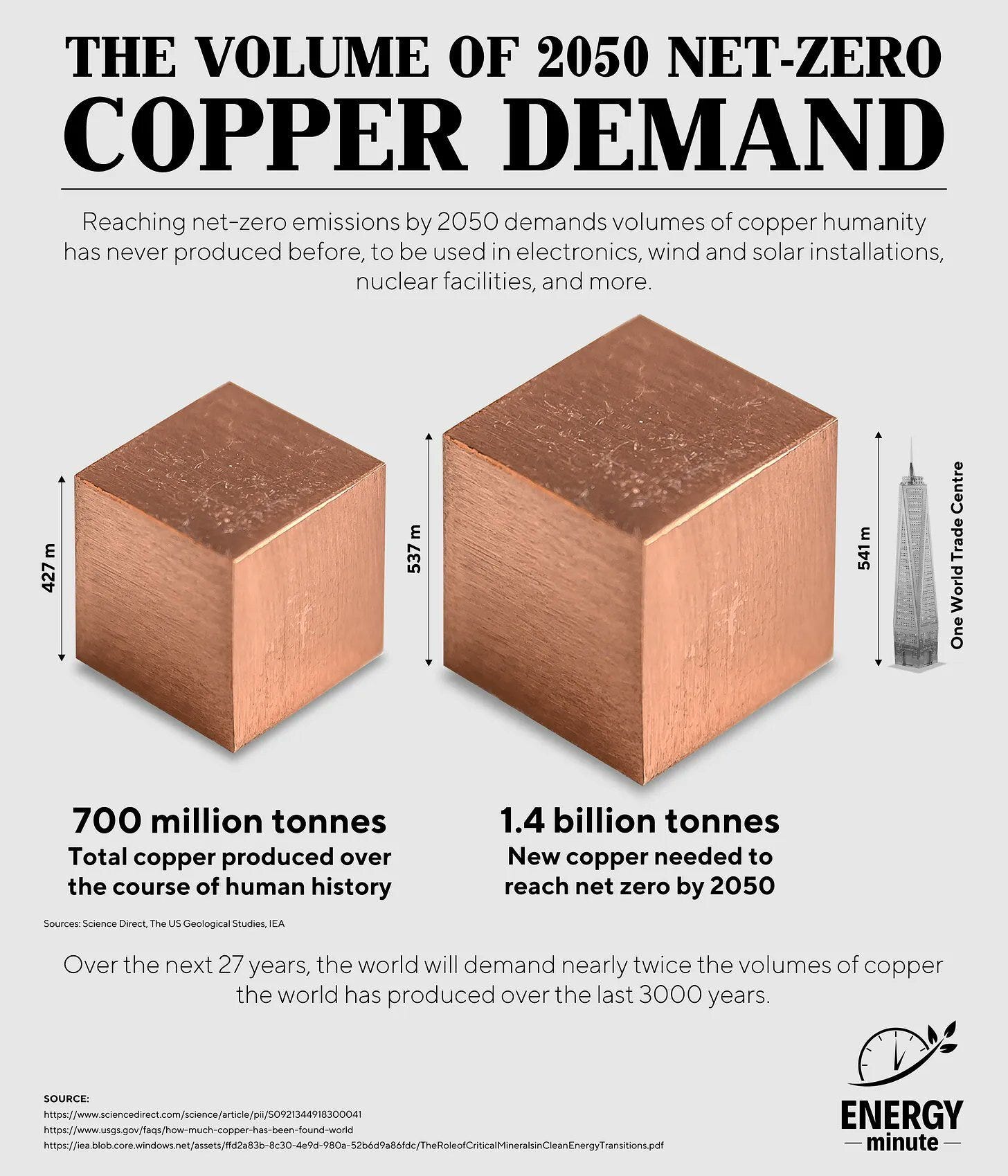Me against the idiocracy: green is the new red
How much longer will we continue to outsource thinking?
Green is the new red. If the first word in Green Deal describes a color, it is the color of money. Accordingly, greenwashing equals money and power.
Energy is the foundation of Maslow's economic pyramid. It provides fundamental human needs such as warm and safe shelter and sufficient calories.
In recent years, there has been a view that renewables can sustain a global industrialized society. Not only can we achieve this, but we must do so retrospectively. The level of ignorance is outrageous.
With today's post, I provoke questions. Questions about the renewable energy narrative.
My point is not to grumble against clean energy. On the contrary, our progress as a civilization runs through evolving as energy producers and consumers. However, this path is long and needs an incomprehensible quantity of energy and materials.
The imposed narrative involves replacing the entire power transmission infrastructure, all energy capacity, and energy sources for heavy industry. This cannot happen either quickly or easily.
The reason is simple - cement, steel, plastic, and ammonia - are the foundation of our material civilization. Their production needs a high-density energy source. Renewable energy does not fall into this category, although it is claimed otherwise.
The following graphic illustrates the point beautifully. Chart via Substack and
Only 20% of the energy is used for electricity generation. The remaining 80% is used to produce steel, cement, ammonia, and plastics.
We don't think about these four elements because we don't feel their absence. If we replace the primary energy source for their production with renewable energy, we will quickly realize how important they are in our daily lives.
A lion never eats grass. And that's what we're trying to do - fuel energy-intensive endeavors with low-density energy sources.
Triangle of Fire for Green Evangelists
I am sick of green hypocrisy. The following graph tells why. Chart via Visual Capitalist.
It graphically demonstrates the extent of hypocrisy among celebrity "environmentalists." All celebrity “green” ambassadors are nothing more than Muppets repeating the required script.
I don't mind the goodies for 1% of the world's population. As they say, If I can afford it, why not enjoy it? However, I do not preach to others how to live.
Three factors fuel the green craze:
Low interest rates + cheap commodities + elite morons = zero carbon emissions by 2050.
The sum of the three variables is indeed equal to zero; however, it is equal to zero sanity.
Much of the "green" energy industry only exists because of three factors. Taken together, they represent the triangle of fire.
The oxygen is low interest rates.
The fuel is cheap raw materials.
The spark is the ridiculous decisions.
Low interest rates and cheap commodities are things of the past. However, the third variable, the incompetent elites, is far from exhausted.
Decisions based on anything but common sense have a peculiar trait. Even if the decision-makers are at the top of the food chain, they cannot defeat physics. In the short term, even the most absurd narrative can trump fundamentals; however, fundamentals, i.e., physics, always win in the long term.
In investor parlance:
In the short term, the narrative trumps the fundamentals. However, the fundamentals trump the narrative in the long term.
The Green Deal is a textbook example of this principle's validity. There is a consensus that the green transition is an easygoing endeavor that is just waiting to be realized. However, the truth is quite different.
Civilization depends on high-energy-density sources, and renewables cannot provide that. Fossil fuels and uranium are the only energy sources with sufficient calorific value to ensure the existence of our material world.
We are far from a green utopia with zero carbon emissions. In 1985, fossil fuels accounted for 88% of total energy consumption, and in 2022, 84%. The following graph shows primary energy consumption and sources for a more detailed look. Chart via Our World in Data.
It is unlikely that 82% of fossil fuel-based energy sources will be replaced by sources currently generating only 13.5% in a few decades. This process requires insane amounts of energy and materials.
I've written quite a bit about commodities. The supply side suffers from a lack of capital investment, a decline in ore grade (most pronounced in copper), and a lack of skilled personnel. All three of the above apply globally. The energy transition and the growing population of the Global South drive demand. Increasing geopolitical risk is impacting both the supply and demand sides.
Cheap commodities fuel the renewables trend; low interest rates are the oxygen. However, these will soon be gone. The reason is that structural inflation is here to stay. It is driven by demographics, geopolitics, and commodities (again).
Demographics in all developed economies, except the US, can be classified as bad or very bad. The reason is the low birth rate and, hence, the falling fertility rate. At least two children are needed to keep population numbers constant. In Europe, the fertility rate is 1.53.
Thus, the number of workers decreases while the number of dependents increases. Fewer people add value to the economy while more consume. In the long run, this process is inflationary.
Over the past two years, geopolitics has returned as a variable determining the state of the global economy. The Middle East is once again in focus. The Red Sea will remain a decisive factor for global supplies. This means longer shipping routes at higher day rates and higher commodity prices for the end consumer.
The deteriorating demographics, expensive raw materials, and geopolitical fragmentation guarantee structural inflation. The latter suggests that the cost of capital will not be as low as it was in the past decade.
So, the required return for renewable energy projects will no longer be a few percent. In economic terms, such projects are not just unprofitable. They destroy capital that could be channeled into profitable ventures.
Return on Energy
Often, the most valuable things are not those whose presence we feel but their absence. Energy (and critical thinking) fall into the latter category.
In most cases, green energy is a business that does not add financial and energy value. Installing solar panels in Northern Europe is as rational as installing hydroelectric power in the Sahara. In the end, green energy turns out to be neither green nor moral. For reference, the cobalt mines in the Congo.
The renewable energy business model resembles economic principles typical of another regime, where the end justifies the means without considering the quality and final cost. Renewables are the socialists of the energy industry—it does not matter if they work or not; they get subsidies in return.
Of course, there are a handful of exceptions. There are regions where certain renewables are the perfect solution for specific purposes. Examples are photovoltaics around the equator or hydropower plants on the headwaters of rivers. Only in such cases do renewables deliver adequate EROI or Return on Energy.
EROI is the number one rule governing the survival of living organisms: to survive, every organism must generate more energy than it consumes. There is no other way around.
Predators do not consume plants because the energy required for their existence exceeds the energy extracted from plants. Accordingly, herbivores obtain sufficient energy by consuming plants.
Energy sources are the same. Building and maintaining renewables consumes more energy than they generate. The following graph shows the EROI or Energy Return on Investment for different energy sources (chart via Substack and
):Renewables are not economically viable to a large extent (below or slightly above the blue line), especially if we consider energy storage CAPEX.
Well, doesn't the sunshine and wind blow free? How come they have the lowest EROI?
At this stage, renewables are irrational because of two parameters: the required area per unit of power generated and the materials required per unit of power. Let's see how much area we need for a gigawatt photovoltaic park:
If we want to install wind turbine blades, the area required becomes downright absurd. I will compare the figures with those of Hinkley Point C NPP, which generates 26 TWh annually and occupies 430 acres. A wind turbine plant would take up 250,000,000 acres for the same output, and a photovoltaic farm would take up 130,000.
Let’s look at the material required. Chart via Environmental Progress.
As you can see, PV requires about 15,000 tons per terawatt hour of electricity, while nuclear requires under 1,000 tons.
How much copper is needed to achieve zero emissions by 2050?
In 26 years, we should produce twice as much copper as we have. We do not have enough operating mines to achieve that goal. Even if several mines of the Escondida scale appear magically, they may start producing copper at least after 13-15 years. In other words, 1.4 billion tons of copper should be mined in under 20 years. The physical constraints are uncompromising—such quantities of copper cannot be mined rapidly.
At this stage, green propaganda is a posh accessory for people who love virtue signaling. Renewables do not justify the inputs of capital and energy.
Conclusion
To be dumb is easy. Nowadays, even more thanks to modern technologies. At the same time, they reward the seeker of knowledge abundantly.
Access to vast amounts and exceptional quality of information has never been so easy. Yet we still have excuses—we don't have time, don't know, don't want to, are tired, etc.
And the excuses are for the victims. Victim mentality means to outsource thinking. Then, you have to whom to blame for your failures. However, this comes at a steep price.
Whoever steers our thinking manages our attention. Where our attention is, our energy and time follow. We are all equal before time because we have 24 hours. How we spend it is entirely our responsibility. Energy is not wasted; it is only transformed. How we use it again is our concern.
This is why green propaganda is so successful. We delegate our attention, time, and energy to someone else’s responsibility. Accordingly, attention is gently directed to the 'appropriate' topics, which are methodically and yet constantly chewed over until they are accepted as absolute truth.
As I have said more than once, it is not the answers that are important but the questions. The answers are already around us; the catch is formulating the right questions. In the case of the Green Deal, they can be boiled down to the following questions:
· How much longer will commodities be cheap enough?
· How much longer will money be cheap enough?
· How much longer will the elites be inadequate enough?
And the most critical question.
How much longer will we continue to outsource thinking?












Excellent analysis.
Most people assume renewable energy is free. But it costs more and produces less relative to fossil fuels and uranium.
Unless we create nuclear power trucks and drilling, we'll always need fossil fuels for mining.
We already have a supply deficit in many critical minerals like copper. The renewable energy requires an astronomical amount more than we currently need. How will increasing the demand and reducing the supply solve anything?
Short, precise, and to the point with great visuals. Well done!